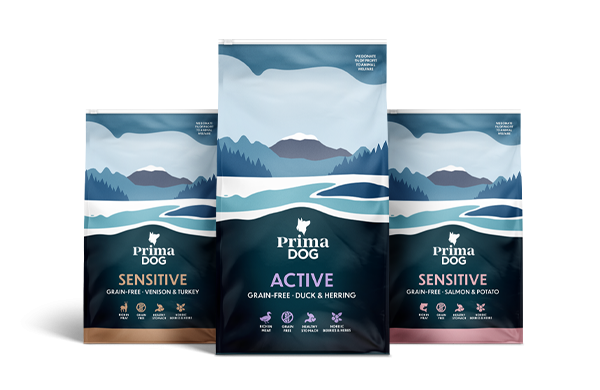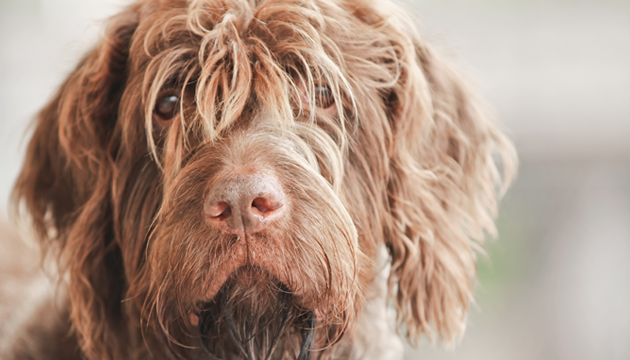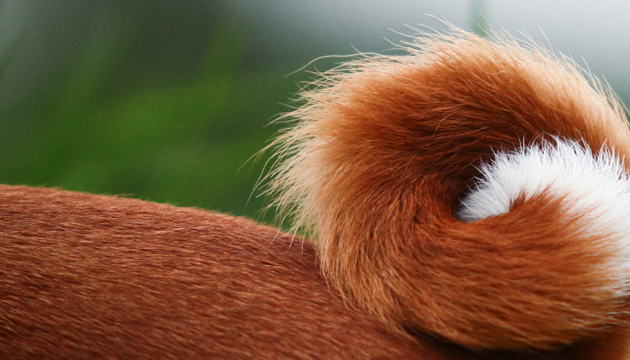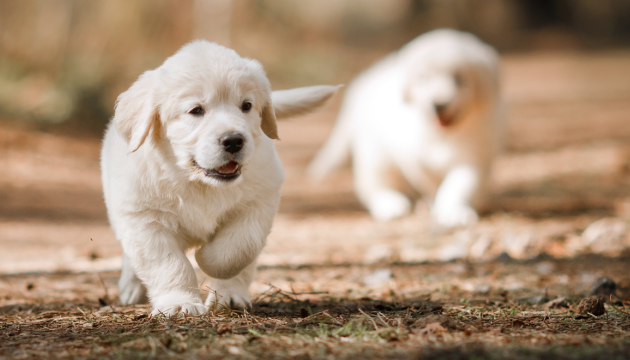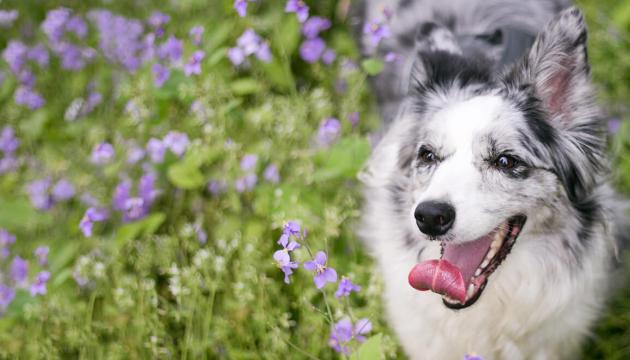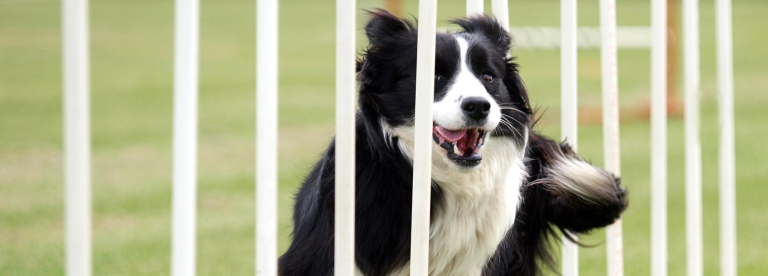

Dog sports & training tips
CHECK OUT OUR TRAINING TIPS FOR TRAINING YOUR DOG
Providing your dog with at least some training makes everyday life easier with your beloved pet. Training your dog ensures that he's safe and welcome everywhere he goes and that he's easy to live with.
When you think of dog training and obedience, the most useful commands are sit, down, stay and come. It is important, that you are able to control your dog in all situations. Basic obedience-training is every dog owner's responsibility, but if you find training with your dog really fun, you can take things further. If you feel that you wish to compete with your dog, there are various dog sports to choose from.
DIFFERENT BREEDS FOR DIFFERENT SPORTS
World Canine Organization (FCI) has approved 358 different dog breeds. All breeds are divided into 10 groups. These groups are based on different attributes such as the dog's appearance or use. The 10 groups include:
- Sheepdogs and Cattle Dogs (except Swiss Cattle Dogs)
- Pinscher and Schnauzer - Molossoid Breeds - Swiss Mountain and Cattle Dogs and Other Breeds
- Terriers
- Dachshunds
- Spitz and Primitive Types
- Scenthounds and Related Breeds
- Pointers and Setters
- Retrievers - Flushing Dogs - Water Dogs
- Companion and Toy Dogs
- Sighthounds
Different dog breeds have different typical features. Some are bred for searching and rescue, some for hunting etc. When considering doing canine sports in a more active way, maybe even competing, it's wise to keep the breed characteristics in mind. The most commonly used sport dogs are Search & Rescue dogs.
SERVICE DOGS
Dobermann, Boxer, German Shepherd, Rottweiler, Giant Schnauzer and Belgian shepherd dogs are the best-known traditional working dog breeds. They are all medium sized, strong and moving dog breeds. The service dogs are bred to assist people in various tasks, for example searching for missing or wounded people and cattle, substances like ammunition or drugs, protecting against unwanted people or criminals and guard the area pointed to the dog.
There are several different sports, that utilize the service dog's natural breed characteristics. Some of them are international competitive sports, and each country might have its own customs and variations on the sport. The most common are:
- Tracking:
the dog is following a trail, set by a person unknown to the dog. There are objects along the trail that the dog has to search and point or bring to the dog handler. The handler comes along with the dog through the trail. - Searching (for a person):
This dog sport is based on the early St. Bernard dog breed that were searching missing people in the Alps back at the 1800-century. The dog searches a "missing person" within a pointed area. Usually, the dog points out the lost person by barking or bringing a specific object to the dog handler. The dog has to find more than just one person it the pointed area. - Article search:
The dog has to find an object the handler has planted into a pointed area. The area size might vary from a few square meters to hundreds of square meters. The dog has to find the object in a given time and point the object to the handler.
OTHER DOG SPORTS
Some dog sports are suitable for all breeds. They provide obedience training, fun and speed. Read a short description about the sports below.
- Obedience training:
the dog obedience is taken to the next level with this sport. The objective is to recognize if the dog has been trained to behave in the home, in public places, and in the presence of other dogs, in a manner that will reflect credit on the sport of obedience at all times and under all conditions.
The handler gets instructions from a judge during the course, and the dog and the handler has to follow those orders strictly and immediately. The dog has to keep a close contact to the instructor at all time. All the commands from the handler to the dog, have to be small and unnoticeable. All the basic training commands are used - sit, down, stay, heel and come.
There are also variations of the obedience training, where the dog not only heels the handler, also retrieves and fetches objects from command. Rally obedience is a bit more fast-paced than the basic obedience. In rally obedience there are signs during the course, which instruct the pair what to do. Unlike traditional obedience, the handlers are allowed to encourage their dogs during the course in Rally obedience. This sport is suitable for all dogs, but it requires plenty of time and effort. - Agility
is a dog sport in which the handler directs a dog through an obstacle course in a race for both time and accuracy. The dog is off leash with no food or toys as incentives, and the handler isn't allowed to touch the dog or the obstacles. The handler can use voice, movement, and various body signals to guide the dog through the course. Various agility obstacles include ramps, tunnels, jump hurdles, wave poles, pause tables etc. Agility requires exceptional training of the animal and coordination skills from the handler. - Sled dog sports
originates from norther and arctic areas, where the dogs have been used in transporting people and goods. Nowadays sledge dogs can compete in pulling for example bikes (bikejoring), sleds, toboggans, skiers, or in one category, the handler is running with the dogs attached to him. Often the very traditional dog breeds are used in sled racing, like Malamutes, Huskies and Samoyeds, but also other mid-sized or large breeds, like Poodles, Pointers, large Terriers and Retrievers can be used. Many times mixed breed-dogs make good sports dogs. - Musical canine freestyle ("Dog dancing")
is a mixture of obedience, tricks, dancing and sometimes high speed. The dog is heeling the trainer, when the trainer is moving along the music. Pivot turning, moving diagonally, backwards and forwards are parts of the routine. The dog also can perform various tricks, such as jump (even over the trainer's arm or back), spin, bow or roll over.
IF YOU DON'T FEEL LIKE COMPETING
The most basic training tips are:
- How to teach the dog sitting: Place the dog in front of you, and pull your hand with the treat over the dog's head. The dog should follow your hand with its nose. When your hand is a bit behind the dogs head, the dog should sit down. Reward by praising the dog while you give the treats.
- When your dog knows how to sit still and patiently, you can teach him to stay. Move gradually away from you dog, whilst asking him to stay. Always reward your dog for staying put, even if it’s just for a few seconds.
WHICH HAND – AN EASY NOSE WORK GAME
One of the first games you can teach your dog is the which hand game; it’s the simplest method to get your dog used to using his nose rather than eyes. Use a piece of food or a small toy and place in inside one of your closed fists. Present your dog with both hands and ask him “which hand?” Praise him when he lightly nudges, puts his nose on your hand, or paws at the correct hand – whichever behavior you prefer.
If your dog chooses the wrong hand open them up to show him where the treat is. Don’t give him the treat just close them and try again. When he gets it right give him a lot of praise and give the treat. Eventually, with simple games like this your dog will begin to start using his natural talent, his nose, rather than relying on visuals.
HIDE AND SEEK
Even though dogs have a sense of smell 1000 times greater than ours they tend to use their eyes a lot. Nose work games helps them focus on smells. To teach your dog to use his nose instead of visuals you’ll want to start with an object that’s really smelly. Treats work well here. Have your dog in his stay position. Place the treat around the corner and just slightly hidden so he’s not just spotting it with his eyes. Your dog might get a little frustrated at first if he’s not able to find the treat immediately.
You can then encourage and praise him when he’s close, you can even point it out to him if he’s having trouble. You’re aiming to make it fun and exciting for him, make sure to praise him when he finds it. You could make it easier on the dog by dragging the object on the floor or making ‘scent pads’ so it is easier to track with the nose. As your dog becomes more adept at sniffing things out you can up the challenge. You can place objects on chairs, under rugs, on the couch, window sills, or anywhere where they are not going to see it right away.
SEARCH FOR TIDBITS
This exercise is suitable for you who has your own garden or similar and want to give your dog a small challenge. Go out into the garden without the dog and throw and spread the tidbits on the lawn. Then let your dog out and exhort him to search, the dog will be working hard with his nose to find every little tidbit. Without much effort, you have given the dog a task which it will take very seriously.
If your four-legged friend needs an extra energy boost, PrimaDog has got your back with our own Grain-free Active Duck & Herring kibble. It's all about finding the right fit, so go ahead and dive into the world of PrimaDog's grain-free dry foods.
